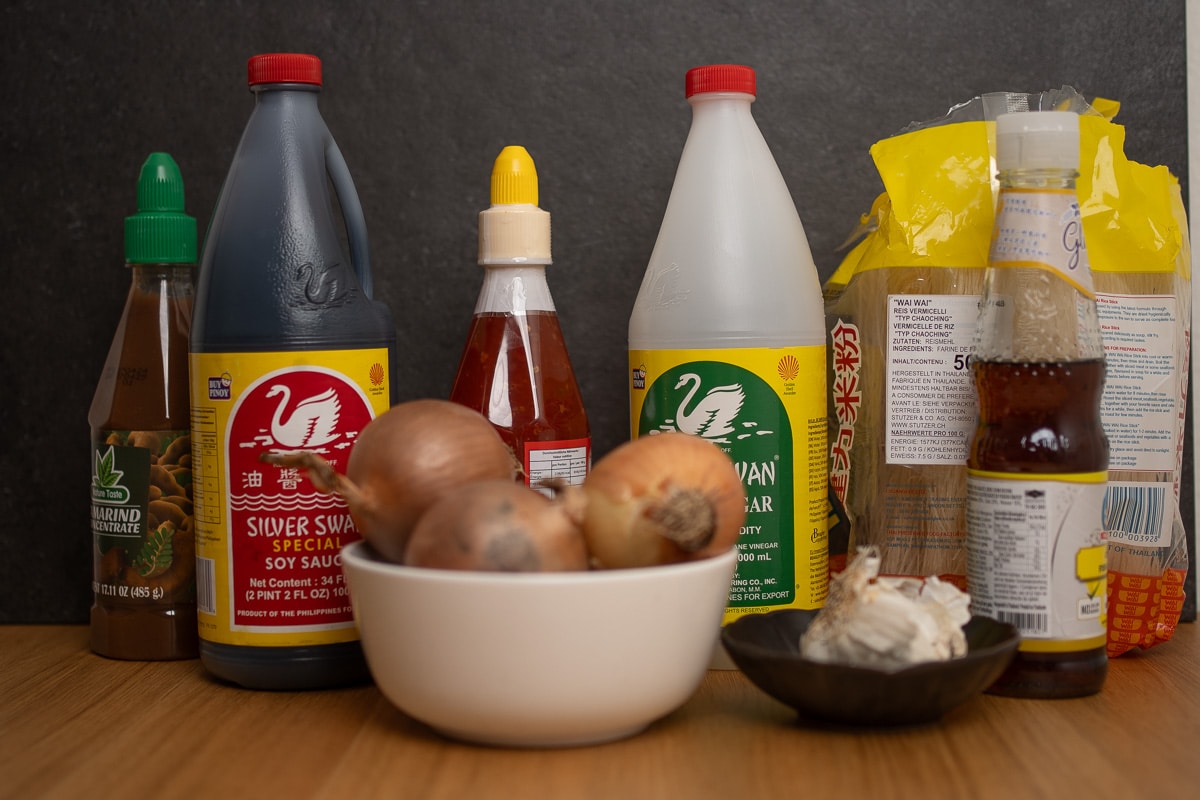In this article, you learn more about the most essential Filipino pantry staples you should stock up on when getting more serious with Filipino cooking. Did you know that Filipino cuisine is a melting pot of flavours influenced by over 300 years of colonial history? It’s true! And at the heart of this rich culinary tradition are the pantry staples that give Filipino dishes their unique taste.
The Filipino often plays with contrasts of the following flavours (salty, sweet, sour and savoury), which you can perfectly experience in my Adobo Chicken Recipe. Also, most of the listed pantries in this Article can satisfy one of these taste genres.
Let’s dive into the world of Filipino pantry staples and unlock the flavours of the Philippines!
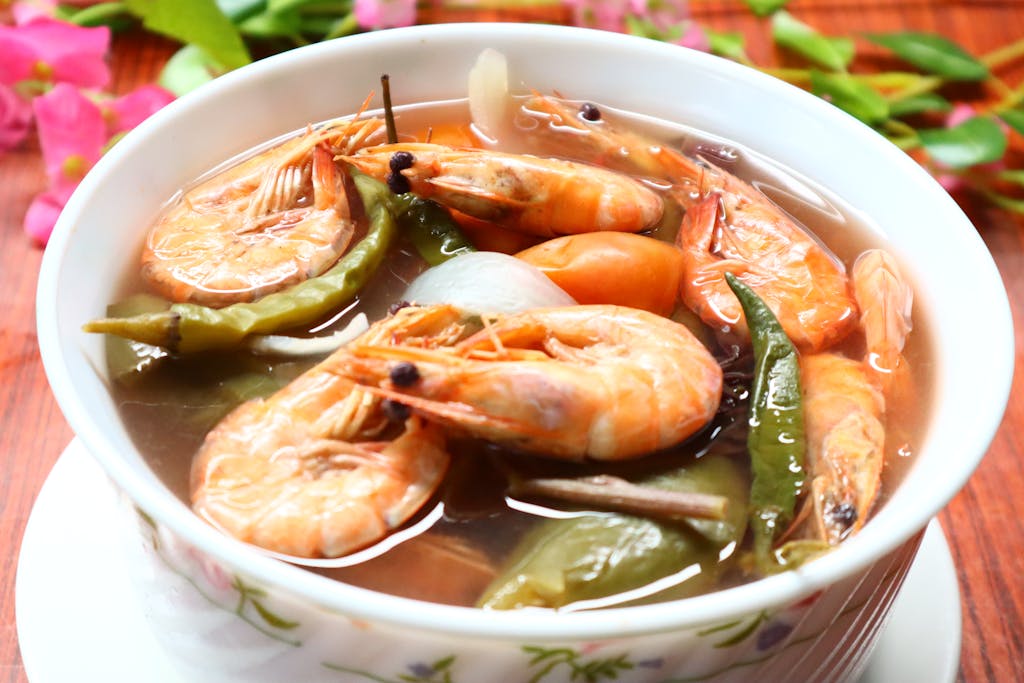
The Top 5 Must-have Filipino Pantry Staples
If I had to decide on the 5 most important Filipino pantry staples, I’d recommend these ones as your basic Filipino grocery list.
Filipino Pantry Staples – Table of Contents
The Foundation: Soy Sauce and Vinegar
Let’s talk about the dynamic duo that forms the backbone of Filipino cuisine: soy sauce and vinegar. These two ingredients are like the Batman and Robin of Filipino pantries – always ready to save the day (or in this case, the dish)!
When it comes to soy sauce, Filipinos don’t mess around. Filipinos use light soy sauce for everyday cooking, dark soy sauce for that rich colour and umami flavour, and even sweet soy sauce for those who like a little sweetness in their lives. Each type brings its own character to the party, and trust me, you’ll want to meet them all!
For my Filipino or other Asian cooking, I always pick soy sauce from the Filipino brand Silver Swan, which I really like.
Now, let’s not forget about vinegar. Oh boy, where do I even start? When I was first introduced to Filipino food, I immediately realized the important role vinegar plays in Filipino cuisine.
There’s Sukang Maasim (cane vinegar), coconut vinegar, Sukang Paombong (palm vinegar) – it’s like a vinegar fiesta. Each one has its unique tang that can make your taste buds do a little happy dance.
Together, soy sauce and vinegar are the power couple that gives Filipino dishes their signature savory-sour punch. They’re in everything from an authentic Adobo to Sinigang, and once you start cooking with them, you’ll wonder how you ever lived without them!
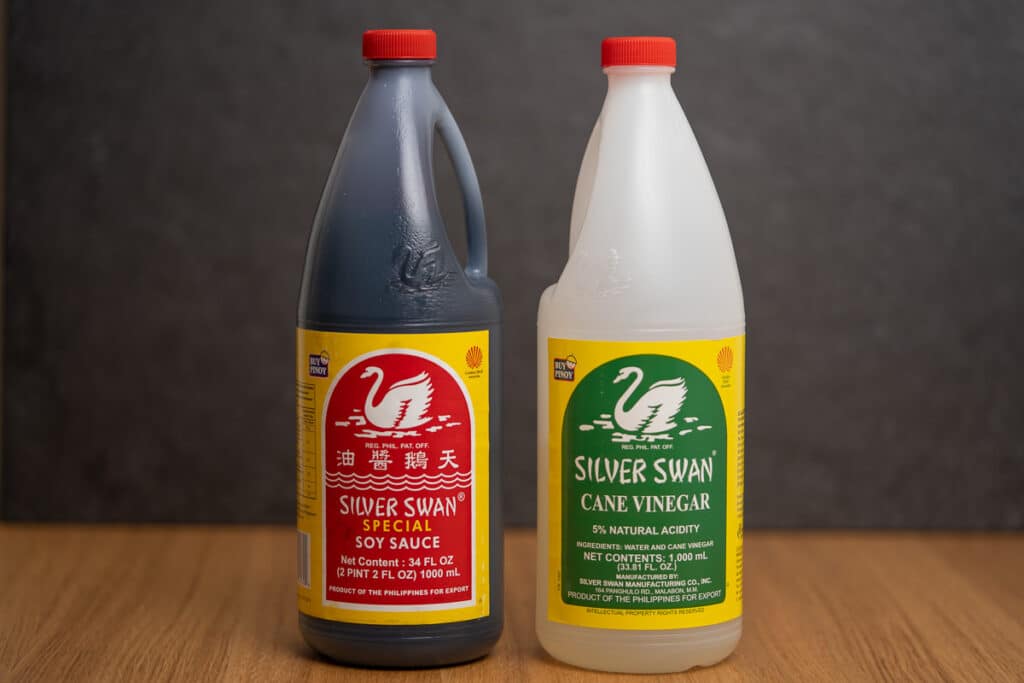
Rice and Noodles: The Staple Carbohydrates
Alright, let’s discuss the real MVPs of Filipino cuisine: rice and noodles. These carbohydrates are the foundation of pretty much every Filipino meal.
First up, rice. It’s not just a side dish; it’s practically a religion. Whether it’s fluffy white rice or sticky rice, Filipinos will find a way to pair it with just about anything. In the Philippines, and many other South Asian countries, Jasmin rice is the type of rice which is consumed the most.
Thai Hom-Mali is probably one of the best and most famous Jasmin rice globally. But when shopping for the best Jasmin rice, be sure to look for the AAA, triple “A” grading, which defines the highest export quality.
But don’t think we’re all about rice. Noodles make things interesting and are used in many Filipino dishes as well. From Bihon (thin rice noodles)used for a Pancit Bihon recipe, to Miki (egg noodles), we’ve got noodles for days. They’re perfect for celebrations, everyday meals, or just when you need a comforting bowl of something delicious.
And hey, for those trying to shake things up, Filipino cuisine is not stuck to only those two types of carbohydrates. Quinoa, Adlai, and other alternative grains are making their way into modern Filipino kitchens.
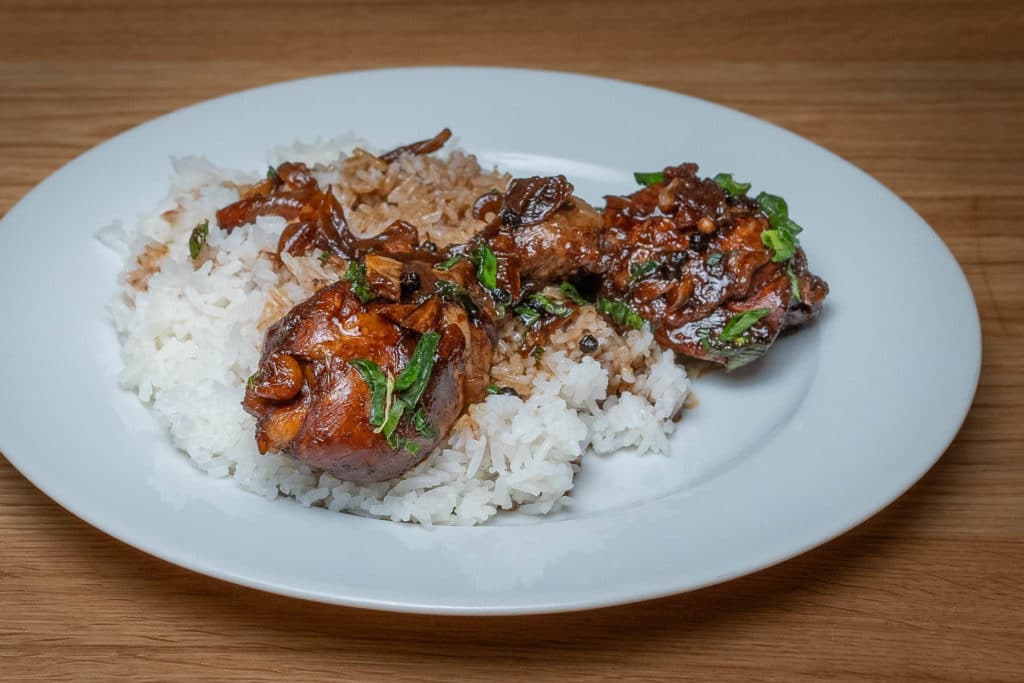
Canned Goods: Convenience Meets Tradition
Now, let’s talk about some Filipino pantry staples that might surprise you – canned goods. For me, these are actually not the highest on the list when thinking about Filipino pantry staples, but for many Filipinos, they are. I know, it doesn’t sound very traditional, but trust me, these little metal containers have found a special place in Filipino cooking.
Corned beef, sardines, and Spam (yes, spam!) are like the holy trinity of Filipino canned goods. They’re quick, they’re easy, and they’ve somehow wormed their way into the hearts of Filipino People and their recipes. It’s like they’ve been adopted somehow into the family and now many Filipinos can’t live without them.
But here’s the kicker – they’re not just consumed straight out of the can (although, no judgment if you do). Filipino cuisine found ways to incorporate these convenient foods into traditional recipes. Corned beef Sinangag or Sardines in coconut milk are good examples of that. I know, dishes with canned ingredients don’t sound like a tasty treat, but don’t knock it till you’ve tried it!
And let’s not forget the cultural significance. For many Filipinos, especially those living abroad, these canned goods are a taste of home. They’re comfort food, nostalgia in a tin, and a way to connect with their roots. Who knew something so simple as these Filipino pantry staples could mean so much?

Coconut Products: Versatile and Flavorful
Let’s take a moment to appreciate the wonder that is the coconut. In Filipino cuisine, the coconut is pretty much a tropical treasure, and boy, does it deliver!
Coconut milk, cream, oil, vinegar – you name it, they use it. It’s like the Swiss Army knife of ingredients. Do you want to add a creamy richness to a curry? Coconut milk has got your back.
But it’s not just about flavour. Coconut products are packed with health benefits too. They’re full of good fats, can help boost your immune system, and some even say they can make your hair shinier. It’s like nature’s multivitamin!
And the best part? Coconut works in both sweet and savory dishes. From creamy desserts to savouy stews, this versatile ingredient can do it all.
Seasonings and Spices: Filipino Pantry Staples for flavouring
Now, let’s spice things up a bit and talk about the unsung heroes of Filipino cuisine – their seasonings and spices. These flavor bombs are what take Filipino dishes from good to “I need this recipe!”
Ginger, Garlic and Onions
These three form the holy trinity of Filipino seasonings. They’re in practically everything, and for good reason – they pack a punch in terms of aromatics.
Achuete
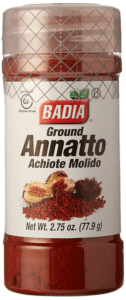
Achuete, also known as Annatto or Achiote powder is a spice derived from the seeds of the achiote tree (Bixa orellana). These seeds are known for their deep red-orange color and earthy, slightly peppery, and mildly nutty flavor.
Atsuete is a staple in a variety of Filipino dishes, providing both color and flavor. Some classic dishes where achuete is commonly used are Pancit Malabon or kare-kare.
Patis
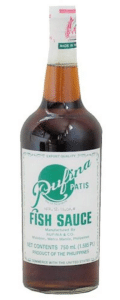
Patis (fish sauce) is used as a flavour enhancer kind of like Maggi in the western world.
Bagoong
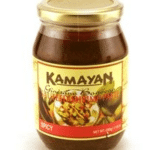
Bagoong (shrimp paste) is fermented seafood, in this case shrimp paste and is used a lot in soups and stews. For that umami kick that’ll make your taste buds sing.
The key to using these seasonings is all about balance. Too much of one thing can overpower the dish, but get it right, and you’ve got a symphony of flavors.
Ube

Ube or purple yam, holds a special place in Filipino cuisine due to its vibrant color, unique flavor, and versatility. It’s cherished not only for its culinary uses but also for its cultural significance.
is primarily used in Filipino desserts and sweets. Its mildly sweet, earthy, and nutty flavor, along with its distinctive purple color, makes it a popular choice for creating visually appealing treats.
Bay Leaves
Bay leaves are commonly used in Filipino cooking, especially for stews like Adobo.
Preserves and Condiments: Adding Depth to Dishes
Last but definitely not least, let’s chat about preserves and condiments. These little jars of joy are the secret weapons in any Filipino kitchen.
The best part? Many of these can be made at home. There’s something special about whipping up your own batch of atchara or mixing your perfect blend of dipping sauce. It’s like you’re carrying on a delicious tradition, one jar at a time!
Atchara
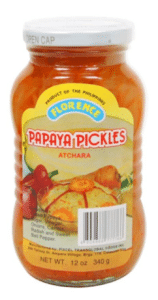
This pickle made from green papaya, is a tangy sidekick that can brighten up any meal. I like pickles like these especially together with some spicy food to compensate for the heat.
Banana Ketchup
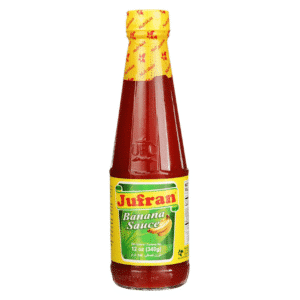
And let’s not forget about Jufran (banana ketchup) – yes, you heard that right. It’s sweet, it’s tangy, and it’s a Filipino favourite. This sauce can be used for several dishes and is often used together with recipes like Tortang Talong (Filipino Eggplant Omelette)
Toyomansi
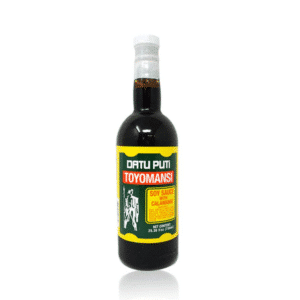
Toyomansi (a blend of soy sauce and calamansi juice) is perfect for dipping and dishes like dumplings or other things.
Conclusion
Now that we’ve explored the essential Filipino pantry staples, you’re ready to embark on your own culinary adventure! These ingredients are the building blocks of countless delicious dishes, from savoury Adobo to Sinigang.
Remember, the key to great Filipino cooking is balancing flavors and experimenting with combinations. So stock up your pantry, fire up that stove, and let’s bring the taste of the Philippines to your kitchen. Masarap!
FAQ’s about Filipino Pantry Staples
What are the most essential Filipino pantry staples to stock up on for authentic Filipino cooking?
The most essential Filipino pantry staples include soy sauce, vinegar, rice, noodles, canned goods such as corned beef, sardines, Spam, coconut products like coconut milk and oil, various seasonings and spices such as ginger, garlic, onions, achuete, patis, bagoong, ube, and bay leaves, as well as preserves and condiments like atchara, banana ketchup, toyomansi, and other flavor-enhancing ingredients.
How do canned goods contribute to Filipino cooking, and what are some popular choices?
Canned goods like corned beef, sardines, and Spam provide convenience and are integrated into traditional Filipino recipes, adding flavor and depth. They are especially important for quick meals and comfort foods, serving as ingredients in dishes like corned beef Sinangag and sardines in coconut milk, and carry cultural significance, especially for Filipinos living abroad.
What types of rice and noodles are popular in Filipino cuisine?
In Filipino cuisine, jasmine rice is most commonly consumed, especially Thai Hom-Mali rice, which is valued for its quality. Noodles such as bihon (thin rice noodles) used in Pancit Bihon and egg noodles like Miki are also popular, often used in celebratory and everyday dishes, providing a carbohydrate base for many meals.
Why are soy sauce and vinegar considered the backbone of Filipino cuisine?
Soy sauce and vinegar are considered the backbone of Filipino cuisine because they form the foundation of many traditional dishes, providing a savory and sour flavor profile. Filipino cooks use different types of soy sauce and vinegar to create a complex taste, with soy sauce adding umami and richness, while vinegar lends a tangy, bright flavor that balances dishes like Adobo and Sinigang.

